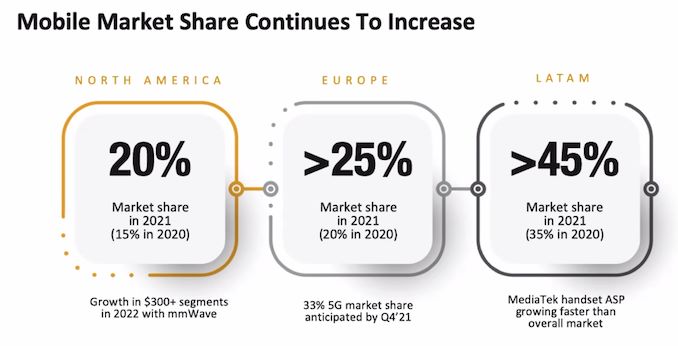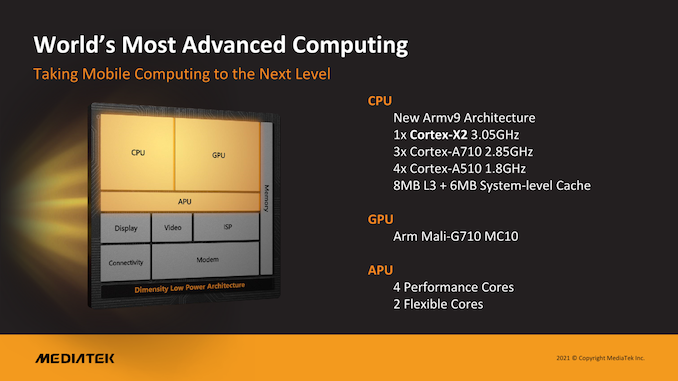MediaTek Announces Dimensity 9000: Supercharged Flagship SoC on 4nm
by Andrei Frumusanu on November 18, 2021 6:00 PM ESTConclusion & First Impressions
MediaTek’s re-entry in the flagship SoC space with the Dimensity 9000 comes at quite the opportunistic time in the landscape. The company has had a very successful 2021 with large market share gains, and we’ve even seen this translate into more exposure in more visible design wins in the market, such as the OnePlus Nord 2 series or the Xiaomi 11T.
Having seen large market share gains and being able to fill in a huge gap in the market where Huawei and HiSilicon were in the past, the Dimensity 9000 seems to have come at the perfect time, as more vendors want to be able to differentiate their highest end devices and diversify their reliance on Qualcomm’s Snapdragon series.
The Dimensity 9000, on paper, and by the specification, looks like an extremely strong SoC for 2022 flagships. On the CPU side of things, MediaTek has fully equipped the SoC with near the maximum possible configuration – high frequencies, large caches, and surprisingly enough for us today, a full performance configuration of the new Cortex-A510 cores. The 8MB L3 is helped by a new 6MB system cache that further improves memory performance, which the Dimensity 9000 of is currently the first and only chip to support new LPDDR5X.
The GPU side, the chip likely will be the only design for 2022 with a large Mali GPU. Advertised performance figures are good, but what matters most is power efficiency and sustained performance. While the metrics here are still a bit vague, the N4 process node of the chip, again, the first of its kind, is likely to position the chip in an excellently against 2021 devices, and if Qualcomm and Samsung don’t have major leaps in their upcoming designs, also position the Dimensity 9000 extremely well against the 2022 competition.
MediaTek’s camera and ISP leaps are also just huge. We haven’t really had many camera-centric phones powered by MediaTek silicon over the last few years, so if vendors are able to take advantage of the chip’s new camera architecture remains to be seen, but at least the high-level specifications are definitely worthy of 2022 flagships.
The chip’s lack of mmWave is likely limit its success to non-US markets and devices, but that’s a situation we generally become used to over the years.
The Dimensity 9000 is MediaTek’s strongest showing in years, and has the specifications and heft to properly shake up the high-end market. I see it competing against, or even besting whatever Qualcomm has in queue for next year, which is a pretty shocking turn of events. What matters now, is for MediaTek to actually have the high-profile flagship device design wins, to be able to fully rationalise their investment in such a SoC. Luckily, we’ve been told the chip has already sampled to customers, and we’re to expect commercial device launches in the first quarter of 2022. Exciting times are ahead in the mobile SoC space.












150 Comments
View All Comments
UNLK A6 - Tuesday, November 23, 2021 - link
Ah, I see the problem. I just looked at my screenshot that I used to make my original post. AnandTech changed the article! If someone can tell me how to post an image, I'll post the screenshot.UNLK A6 - Tuesday, November 23, 2021 - link
To see the original slides, they're still at 9to5google.com. Search for "Dimensity 9000".UNLK A6 - Tuesday, November 23, 2021 - link
...And notice they credit AnandTech for those images. What the heck AnandTech, how about a remark someplace that you changed the article!Wilco1 - Thursday, November 25, 2021 - link
Some other sites show a very different set of slides (with different layout and colors) and in one of those the bars are wrong indeed. However I never saw those slides on AnandTech eventhough I read the article fairly early as there were only a few comments. So if the wrong slides went live, it must have been for a short time.UNLK A6 - Friday, November 26, 2021 - link
So,- I take a screenshot of bogus MediaTek charts at 2021-11-18 at 5.28.18 PM (PST).
- I criticize AT for publishing bogus charts.
- AT switches out the charts for new ones. Who knows when or why?
- AT doesn't mention they did so in the article or in this thread.
- AT lets this thread play out making me look the idiot.
- I finally realize what happened by looking back at the charts and my screenshot. I prove that AT switched them by citing other articles sourcing the bogus charts to AT.
- AT still makes no comment here.
Classy, Andrei, classy. And you were someone whom I respected by engaging in the forum comments. Well, lesson learned.
mode_13h - Saturday, November 27, 2021 - link
> - AT still makes no comment here.You can't assume they read all the comments. I agree they should've noted when they update graphs, but your best option for complaining about it is either on Twitter or maybe you could try the "Forum Feedback" in the main forums. Unfortunately, the "Contact" link in the page footer just goes to some business-oriented page for the parent company.
UNLK A6 - Saturday, November 27, 2021 - link
Thanks for the thoughtful advice. I appreciate it.UNLK A6 - Sunday, November 21, 2021 - link
Oh, and you probably also vindicated MediaTek's strategy to mislead, which probably wasn't your aim.UNLK A6 - Sunday, November 21, 2021 - link
@Tomatotech, dividing the wrong way around is an easy mistake to make. I didn't need to be snarky and I apologize to you and other readers here. I wish I could edit out the snark. Mostly I wanted to ask the authors and editors to not publish junk charts from MediaTek (and others). Again, AnandTech, please don't publish this crap. Or better yet point out the glaring deception.Wilco1 - Tuesday, November 23, 2021 - link
There is no deception from MediaTek. You are the one dividing the wrong way, 35% uplift means 1.35 times the performance and thus 1.35 times the height, which is exactly what the graph shows.